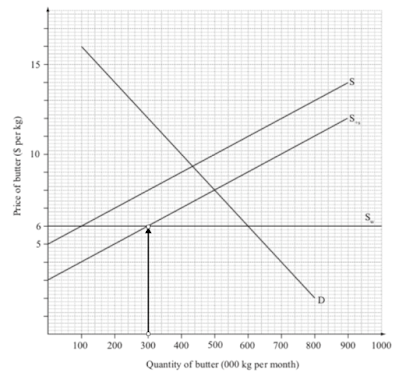2014#2 Subsidy Paper 3 HL
(e) The diagram above represents the market for butter in Gondowa. Domestic supply
and demand curves are given by S & D, while butter can be imported at the world price of $6/kg (Sw).
The government of Gondowa decides to grant a subsidy of $2 per kg to domestic producers of butter.
(1) State the monthly volume of domestic production before the subsidy is granted.
Before the subsidy with a World Price of $6 domestic suppliers will only produce 100,000 units per month.
(1) State the volume of imports before the subsidy is granted.
(1) On the diagram, draw the new domestic supply curve for butter and label it S+s.
Remember that if you don’t label the new supply curve you can only achieve 1point maximum.
Label your curves!!!!
(4) Calculate the level of government spending required in financing this subsidy.
At a world price of $6 and a $2 subsidy domestic producers will produce only 300,000 kg’s of butter.
300,000 x 2 = $600,000
Gov’t Spending = the final level of domestic output x subsidy per unit
At a world price of $6 and a $2 subsidy domestic producers will produce only 300,000 kg’s of butter.
300,000 x 2 = $600,000
Gov’t Spending = the final level of domestic output x subsidy per unit
(f) Using your answers to part (e) and your knowledge of economics, explain two disadvantages to Gondowa of the introduction of a subsidy on butter.
- Subsidies are financed by the government (the people) $600,000 in this case so opportunity cost is involved.
- Subsidies to domestic firms may be seen as protection and this may give rise to retaliation from trading partners.
- Subsidies distort the pattern of trade, allowing domestic producers to survive in the face of more efficient foreign competition. Thus gains from comparative advantage will be lost, leading to reductions in efficiency.
- Subsidies may be seen as protectionism and may give rise to sanctions from the WTO









No comments:
Post a Comment